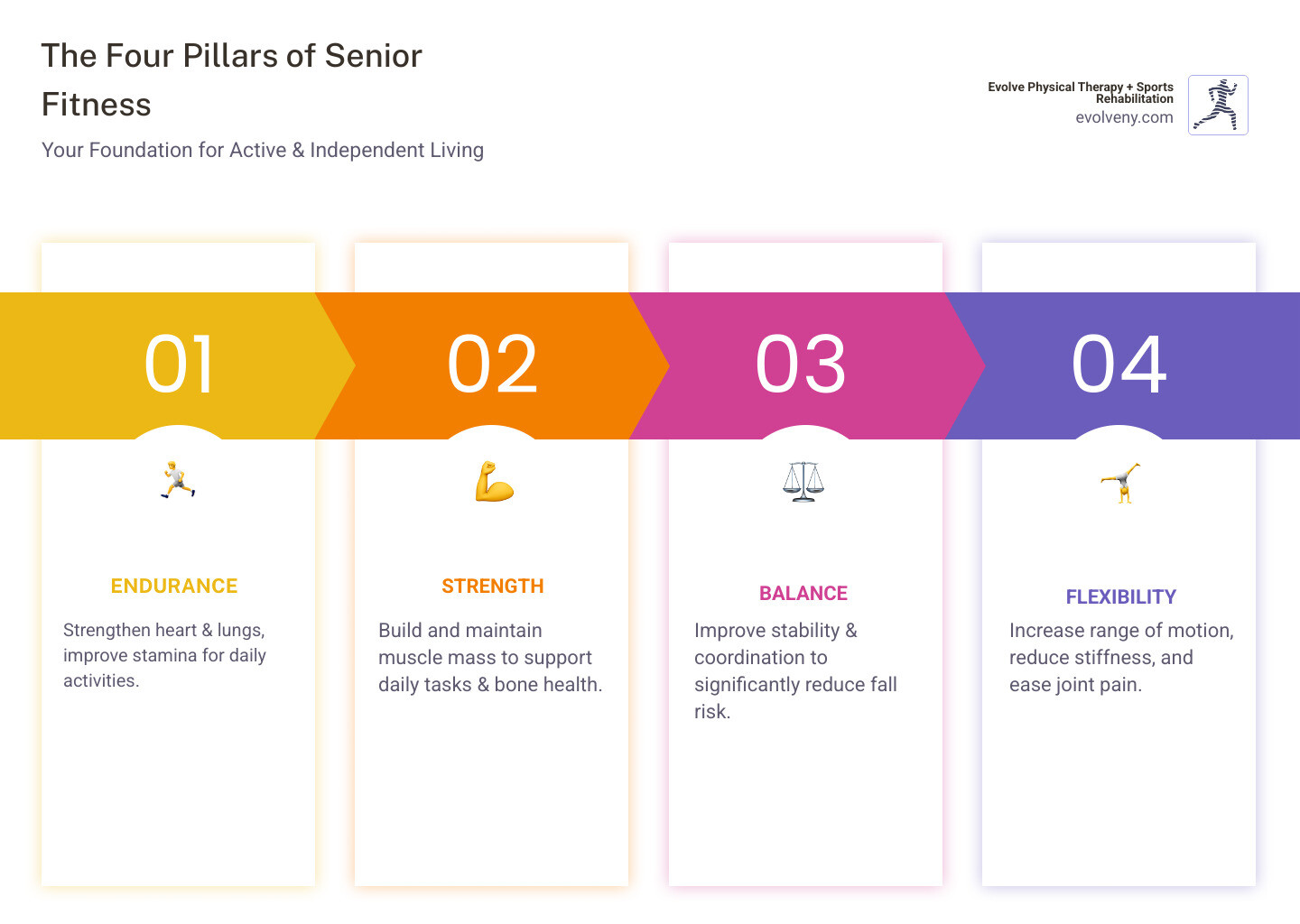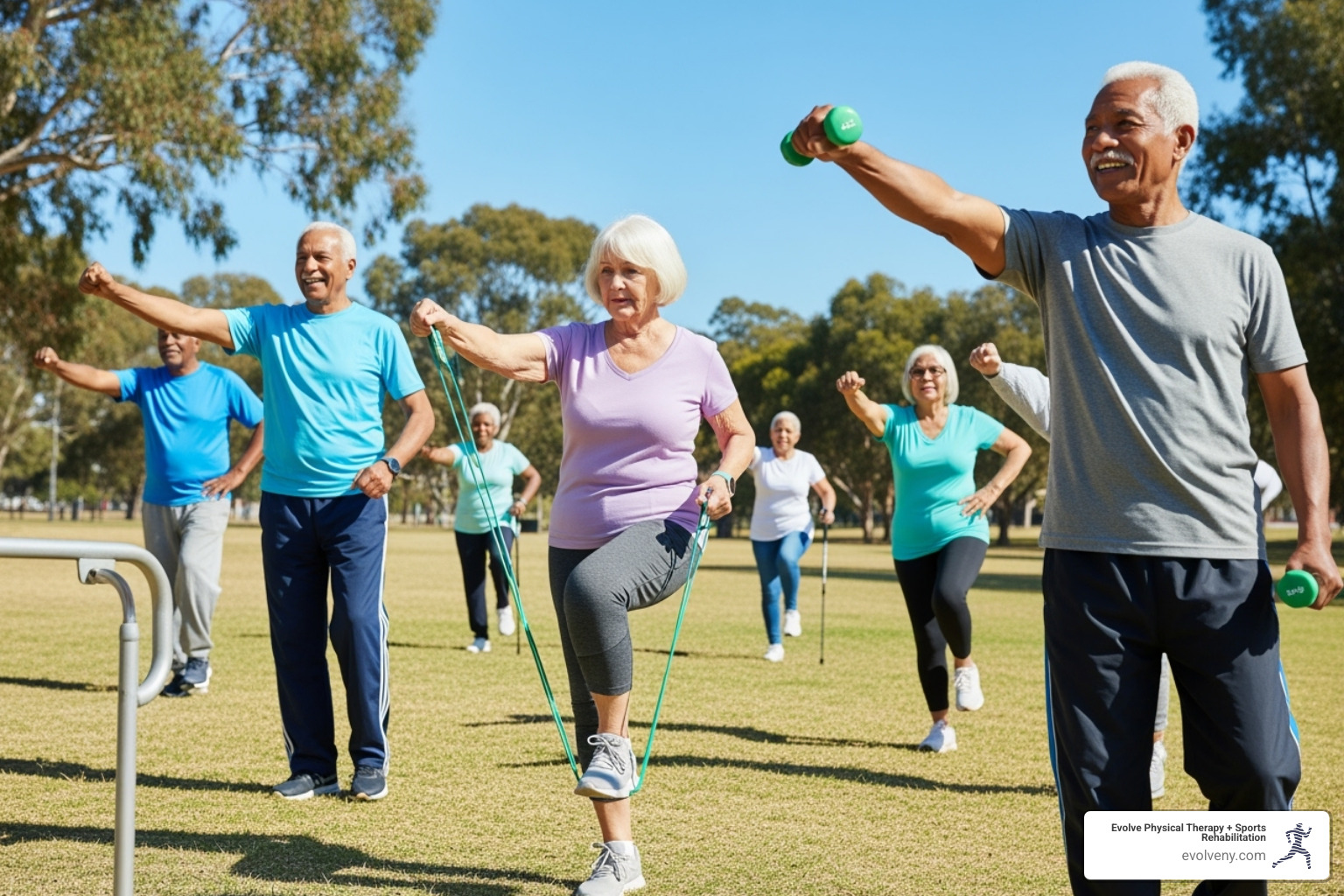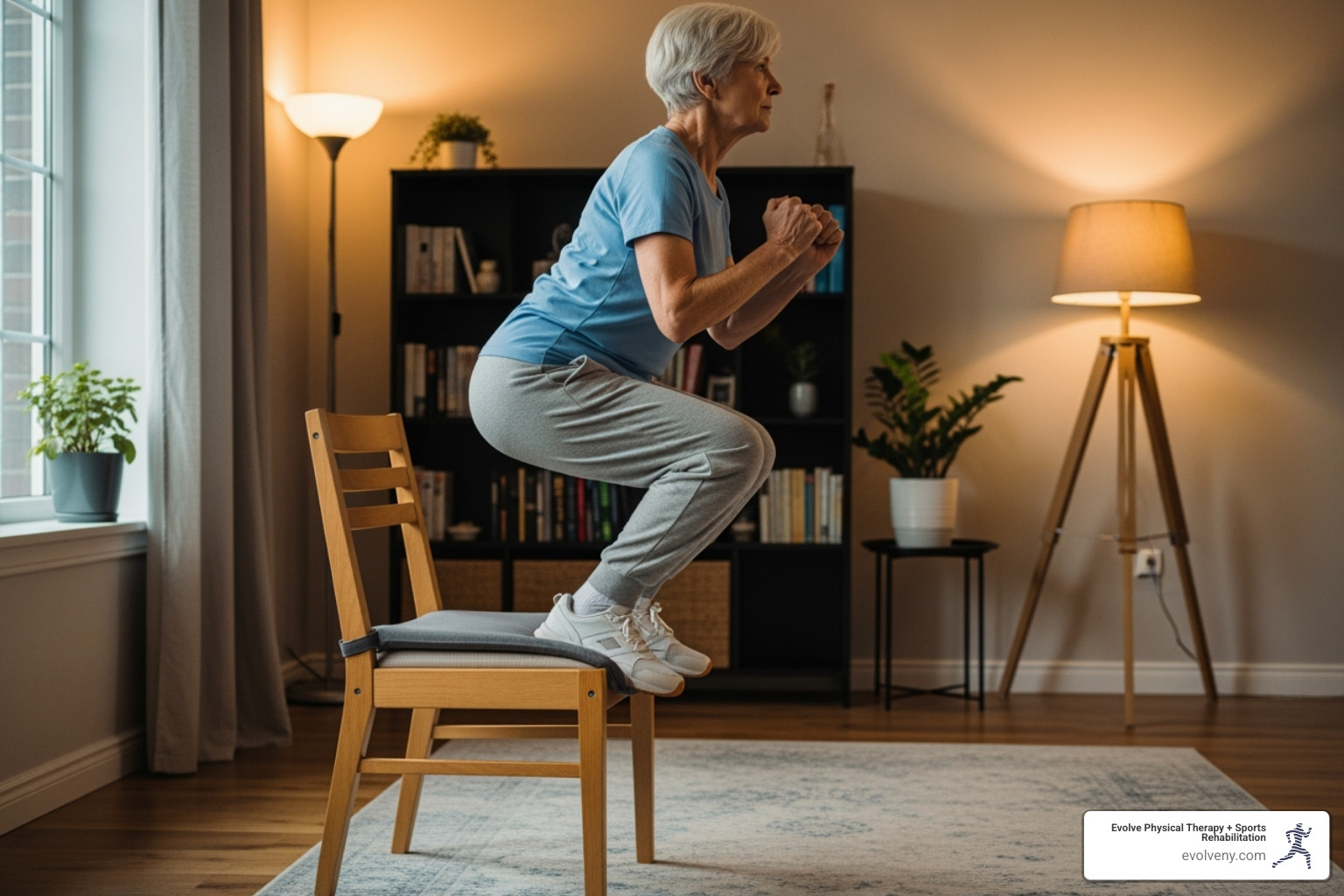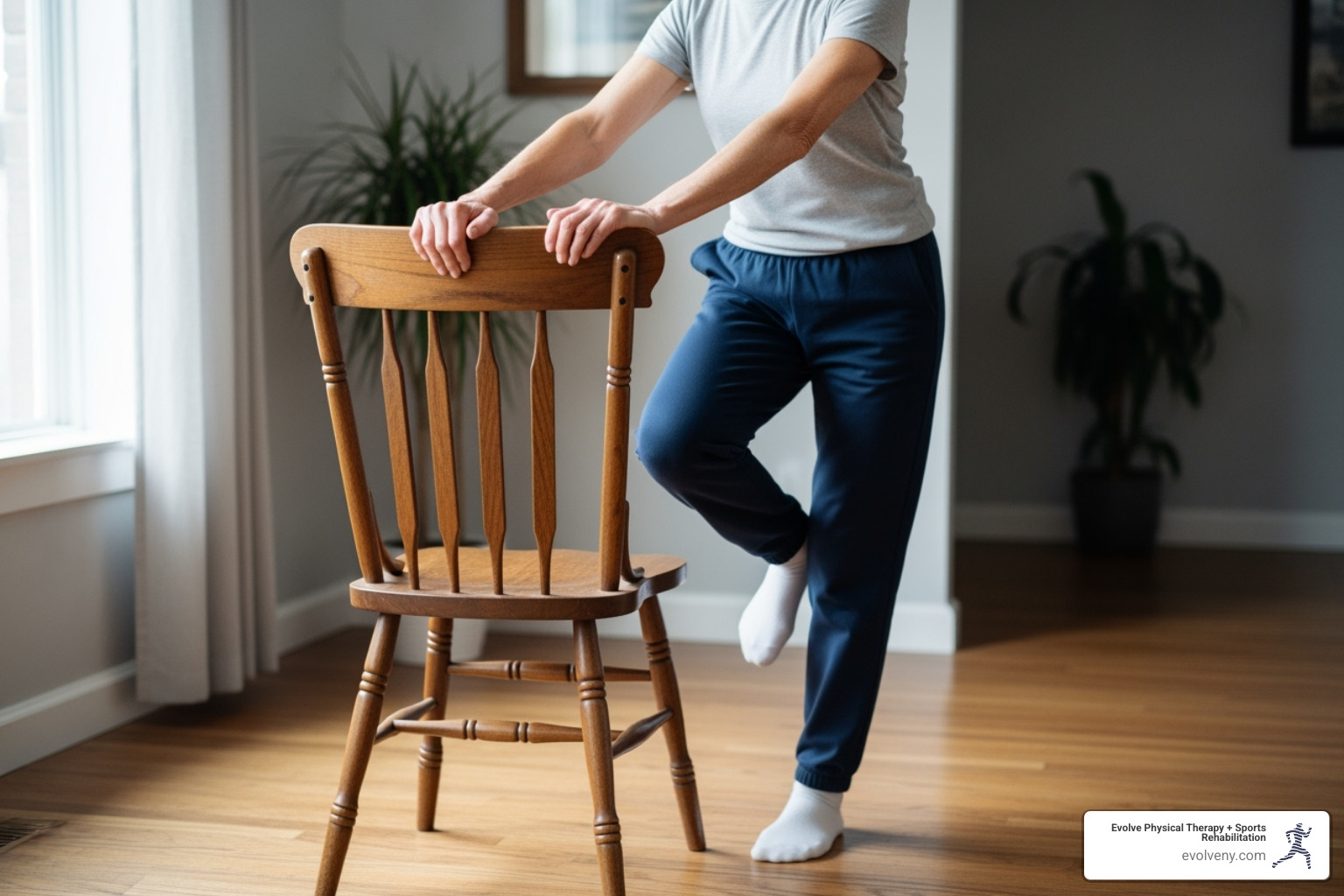Step Up Your Game with Mobility Exercises for Seniors
Why Staying Mobile is Your Gateway to Independent Living

Elderly mobility exercises are specialized movements designed to improve strength, balance, flexibility, and endurance in older adults. These simple activities can dramatically reduce fall risk, ease daily tasks, and help you maintain the independence you value. As we age, our bodies naturally lose muscle mass and flexibility, but regular movement can slow or even reverse many of these changes.
Key Benefits of Elderly Mobility Exercises:
- Reduce fall risk by 35-45% through improved balance and coordination
- Maintain daily independence by making tasks like getting out of bed or climbing stairs easier
- Manage chronic conditions like arthritis through improved circulation and reduced stiffness
- Strengthen bones and muscles to combat age-related decline
- Boost mental health and cognitive function
Falls affect 35-45% of seniors annually, with over 800,000 requiring hospitalization. Most are preventable through targeted exercises that address declining strength, balance, and mobility.
I'm Lou Ezrick, a licensed physical therapist with nearly two decades of experience. At Evolve Physical Therapy, I've seen how the right elderly mobility exercises transform lives, helping seniors stay active, confident, and living on their own terms.

Why Mobility is Your Key to a Vibrant Life
Mobility is your personal freedom pass—the ability to move comfortably without pain. It's what lets you reach for a high shelf, tend your garden, or get out of bed with ease.
A major concern for older adults is falls, often caused by deconditioning from inactivity. The good news is that this is preventable. Elderly mobility exercises build a protective shield against falls by improving balance and coordination, giving you the confidence to move freely.
The benefits extend beyond fall prevention. Regular movement improves quality of life by making daily tasks easier and reducing joint stiffness, which is a great relief for those with arthritis. It also boosts improved cognitive function and provides the satisfaction of staying independent.
The Four Pillars of Senior Fitness
The CDC recommendations highlight four essential types of movement:
- Endurance: Keeps your heart and lungs strong for activities like walking or swimming.
- Strength: Fights age-related muscle mass loss, making it easier to carry groceries or stand up from a chair.
- Flexibility: Keeps joints moving freely, reduces stiffness, and helps lower the increased risk for osteoporosis.
- Balance: Your best defense against falls, improving stability with regular practice.
The CDC suggests 150 minutes of moderate activity weekly, plus strength and flexibility work twice a week. We'll show you how to make this manageable.
The Critical Link Between Balance and Flexibility
Balance and flexibility are interconnected. Good flexibility allows your body to adjust to uneven surfaces, preventing falls. A shoulder flexibility decline study shows we lose shoulder mobility each decade, but exercise can combat this. When your joints move freely, your body coordination and spatial awareness work together to keep you stable, building confidence in movement.
Getting Started: Safety First and Always

Before starting any elderly mobility exercises, the non-negotiable first step is consulting with your doctor or a licensed physical therapist. They can tailor a plan to your health history and needs, a step emphasized by the National Institute on Aging.
Once you have approval, set yourself up for success:
- Warm-up: Prepare your body with a few minutes of light cardio, like marching in place or arm circles.
- Cool-down: After exercising, help your heart rate return to normal and prevent stiffness with gentle stretches or slow walking.
- Proper clothing and hydration: Wear loose-fitting clothes and keep a water bottle handy.
- Listen to your body: Understand the difference between the mild discomfort of working muscles and sharp pain, which is a signal to stop immediately.
Exercises Seniors Should Approach with Caution or Avoid
While staying active is key, some exercises carry unnecessary risks. Be cautious with or avoid:
- High-impact exercises: Long-distance running or jumping can be hard on the joints.
- Heavy weightlifting: This includes deadlifts, full squats with heavy weights, and bench press exercises, which can strain the back, knees, and shoulders.
My golden rule is to stop any exercise causing sharp pain. Safer alternatives exist for nearly every risky exercise. For example, try wall push-ups instead of bench presses, and chair squats instead of weighted deep squats. The goal is to build strength and mobility without risking injury.
10 Foundational Elderly Mobility Exercises
Now, let's explore some of the most effective elderly mobility exercises to transform your daily life. These movements target key areas for maintaining independence. Think of them as your daily toolkit; you don't need to do them all every day. Start with a few and build your routine gradually, as consistency is more important than intensity.
Flexibility and Stretching: Your Foundation for Movement
These gentle stretches improve flexibility, helping you move with less stiffness. Hold each stretch for 10-30 seconds while breathing deeply.
Overhead Side Stretch: Ideal for improving reach. Stand or sit tall. Raise both arms overhead, clasping your hands. Gently lean to one side, feeling a stretch along your opposite side. Keep your shoulders relaxed. This improves flexibility in your shoulders, upper back, and torso.
Neck and Shoulder Stretches: These release common tension. Neck Turns: Gently look over one shoulder, hold, and repeat on the other side. Ear-to-Shoulder: Gently tilt your head, bringing your ear toward your shoulder. Shoulder Rolls: Roll shoulders forward, then backward. These movements improve posture and range of motion. For a visual guide, see this neck and shoulder mobility video.
Hamstring Stretch: Seated: Sit on a chair's edge with one leg extended, heel on the floor. Lean forward from your hips with a straight back until you feel a stretch. Standing: Place one heel on a low step, keep the leg straight, and lean forward from the hips. This stretch targets muscles that get tight from sitting, which helps walking and lower back health.
Ankle Rotations: Crucial for balance. Sit in a chair and lift one foot. Gently rotate your ankle in slow circles, clockwise then counter-clockwise. Repeat on the other foot. This improves ankle mobility, which is vital for stability and fall prevention.
Strength Training: Building a Resilient Body
Strength training makes daily tasks easier and keeps bones healthy. Aim for 8-12 repetitions, working up to 2-3 sets as you get stronger.
Chair Squats: A highly practical exercise. Sit on the edge of a sturdy chair, feet shoulder-width apart. Push through your heels to stand up, keeping your back straight. Slowly lower yourself back down. This strengthens your legs and glutes, making it easier to get out of chairs and cars. The sit to stand exercise benefits are significant for functional mobility.

Wall Push-ups: A joint-friendly alternative to traditional push-ups. Stand arm's length from a wall. Place hands on the wall, slightly wider than your shoulders. Lean in, bending your elbows while keeping your body straight. Push back to the start. This strengthens the chest, shoulders, and triceps for pushing and lifting.
Glute Bridges: Excellent for glutes and back health. Lie on your back, knees bent, feet flat on the floor. Lift your hips until your body is in a straight line from shoulders to knees. Hold, then slowly lower. This strengthens glutes and hamstrings, which are vital for walking and supporting the lower back.
Seated Row with Resistance Bands or Light Weights: Improves posture and pulling strength. Sit tall in a chair with a resistance band looped around your feet or holding light weights. Start with arms extended. Pull your elbows back, squeezing your shoulder blades together. Slowly return. This strengthens your upper back and biceps.
Balance Boosters: Essential Elderly Mobility Exercises for Fall Prevention
Balance improves with practice. These exercises challenge your stability. Always have a sturdy chair or wall nearby for support.
Single-Leg Stance: A highly effective balance exercise. Stand next to a sturdy chair for support. Slowly lift one foot, bending the knee, and hold for 10-30 seconds. Repeat on the other side. As you improve, rely less on the support. This strengthens thighs and key stabilizer muscles.

Heel-to-Toe Walk: Improves dynamic balance. In a clear space, walk by placing the heel of one foot directly in front of the other's toes. Gaze forward, not down. Take 10-15 steps, using a wall for support if needed. This is essential for steady walking.
Tree Pose with Chair Support: A gentle yoga pose for balance. Stand next to a chair for support. Shift your weight to one foot and place the sole of your other foot on your standing ankle or calf (avoid the knee). Focus on a spot in front of you. Hold for 10-30 seconds, then switch sides. This strengthens the standing leg.
Side Leg Raises: Targets key muscles for walking stability. Stand behind a chair for support. Slowly lift one leg straight out to the side, keeping your torso upright. Lift only as high as is comfortable and controlled. Lower slowly. Repeat 10-15 times, then switch sides. This strengthens hip abductor muscles to prevent wobbling.
Fun and Engaging Ways to Improve Mobility
Staying mobile doesn't have to feel like work. The most effective elderly mobility exercises are often the ones that bring joy into your day. When movement is enjoyable, consistency becomes effortless.
Consider these fun options:
- Gentle stretching or chair yoga classes: These are welcoming, non-intimidating spaces to move at your own pace, with the security of a chair for support.
- Group movement classes: Connecting with others adds motivation. Water aerobics is a great option, as the water supports achy joints while providing resistance.
- Light dancing: Put on your favorite music! Dancing is a fantastic way to improve coordination and balance while lifting your spirits.
- Walking groups: Turn a simple stroll into a social event, strengthening your legs and heart while you chat.
- Tai Chi-inspired movement: These slow, flowing movements are highly effective for improving balance and flexibility.
The most valuable guidance often comes from activities led or recommended by a physical therapist. At Evolve Physical Therapy, we see how personalized, enjoyable programs transform mobility and confidence.
Frequently Asked Questions about Elderly Mobility Exercises
Here are answers to some of the most common questions about elderly mobility exercises.
How often should a senior perform mobility exercises?
The CDC recommends 150 minutes of moderate activity per week for adults 65 and older. This can be broken into 30 minutes five days a week, or even shorter 10-15 minute sessions.
- Strength and flexibility: Aim for at least 2 days per week.
- Balance: Aim for 3 days per week to reduce fall risk.
Consistency beats intensity. Starting with 5-10 minutes of gentle movement daily is better than one long, infrequent workout. Start slow, gradually build up, and even light activities like gardening or stretching during TV time count.
Can these exercises help with arthritis pain?
Yes. Contrary to the belief that movement worsens arthritis, regular, gentle elderly mobility exercises are highly effective for managing symptoms.
- Improved circulation: Movement delivers nutrients to your joints and helps flush out inflammatory waste.
- Reduced stiffness: Gentle stretching prevents the stiffness that comes from inactivity and helps maintain range of motion.
- Stronger support: Strengthening the muscles around a joint provides better support and takes pressure off the joint itself.
Many of these exercises are low-impact (e.g., water aerobics, chair exercises), putting minimal stress on joints. Always listen to your body; mild discomfort is normal, but sharp pain is a signal to stop.
What if I use a walker or have very limited mobility?
Movement is beneficial regardless of your current mobility level.
- Chair exercises are powerful: You can do many strength, flexibility, and cardio exercises from a seated position, such as seated rows, ankle rotations, and shoulder stretches.
- Use your walker as a tool: A walker can provide stability for standing exercises like marches in place, side leg lifts, or calf raises. Ensure the brakes are locked if applicable.
Even small, controlled movements help prevent deconditioning (the weakening from inactivity). Consulting a professional is invaluable here. A physical therapist can create a safe, personalized program of elderly mobility exercises custom to your abilities. The goal is to maintain your quality of life, and every movement is a victory.
Conclusion: Your Path to Better Mobility Starts Now
You now have the tools—from foundational exercises to safety tips—to transform your daily life with elderly mobility exercises. The benefits are life-changing: reduced fall risk, less arthritis pain, stronger muscles, and the confidence that comes with independence.
Your body is adaptable at any age, and consistency is your secret weapon. Start with just five minutes a day; these small steps build lasting change. Think of movement as medicine. The right exercises can be more powerful than many medications, with only positive side effects.
At Evolve Physical Therapy + Sports Rehabilitation, we see these changes daily across our Brooklyn community, from Marine Park to Park Slope. Our hands-on, personalized approach helps seniors regain strength and confidence. Physical therapy isn't just for recovery; it's about preventing problems before they start. Our specialized programs, like the NBC News-featured Rock Steady Boxing for Parkinson's, show how targeted, enjoyable movement can make all the difference.
Your journey to better mobility and improved quality of life starts with the first step. Your future self—walking confidently and living independently—is waiting.
Learn more about physical therapy for seniors and find how personalized care can accelerate your progress toward better mobility and lasting independence.

